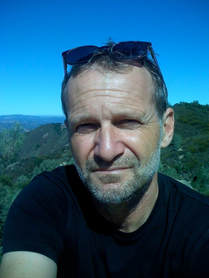Jerry HirniakJerry Hirniak was the featured artist for C4's 2014-15 season.
I was approached by members of C4 to be part of their tenth season as a contributing visual artist. The four works I chose to donate reflect the complexity, range and sense of place that I have felt listening to their music over the years. Each piece captures an elusive, fleeting moment in the history of the city:
|
The Manhattan skyline from the top of the Empire State Building
[This] work reflects on the implications of the massive numbers of photographs that can be captured and displayed in a digital environment. My goal is both to force the viewer to rethink what an image is and to create the possibility for me as a photographer to maintain a constant questioning of the representational possibilities and limitations of the photographic medium. I am interested in a hybrid practice where the photographic image does not exist solely as a discrete framed element, solidifying one perspective, but opens up to the complexity of many perspectives and the possibilities of other ways of understanding the world.
5 Pointz
With the advent of readily available and affordable digital cameras in the 90’s, I started to re-think my approach to how to take a picture, what to take pictures of, how to view them and ultimately how to use photographic process to connect to a subject. Small memory cards and low battery capacity defined my early experiments with shooting in burst mode. My current show is built on the experiments and lessons of years of using the action of photographing as an integral partner to the subject of each frame. A “photograph” became a short abbreviated slide show reflecting and commenting on the question of capturing one ideal image. The current body of work encompasses a number of different ways of thinking about the intersection of digital modes of photography, painting and drawing.
Occupy Wall Street
The digital contact sheet contains a complete record of images shot in continuous mode, unedited for selection, order, or chronology. Each contact sheet records thousands of repetitive images of the ordinary as well as the momentous destinations of travel, events, the every day and of isolated subjects and concepts. The contact sheet stands against the iconic photograph to record the act of recording; and the profusion of images possible in digital formats, like big data, provides alternative cognitive maps of experience. Each image is equal as a fragment and clear as a particular, but together as a contact sheet generated by the computer form a field of abstraction suggesting different and mysterious patterns unavailable to conscious representation. This work is the latest iteration of a decades-long investigation into the technology of the photographic image and its relation to process and experience. My early work used Xerox technology and extreme enlargement to critique the image, while later work used technologies of tiling to fragment, complicate and question the image and representation. Digital photography allowed me to incorporate temporality without filmic or theatrical narrative by using continuous shot mode to capture constant change and variation. I have created video works using thousands of images to represent a world hovering between reference and abstraction, resisting and embracing the tyrannies of both. I have also worked with the portrait in this mode as a performative and temporal relation between photographer and sitter.
The Whitney
|
|
|
C4 is funded in part by:
C4 is a proud member of:
New York Choral Consortium |
Receive our newsletter:
Support C4's Mission!
|










